
|
AN EARLY 19TH CENTURY MEDICINE CHEST
with largely complete contents comprising 15 graduated drug bottles with glass stoppers and partial contents, and drawer with inset handle with poison bottles, measuring flask etc. (8½ x 8¾in.) (21.5 x 22cm.)
£300-500
|
|

|
A PRECISION BALANCE BY L. ORTLING, LONDON, CIRCA 1890
signed in the beam as per title and inscribed To Weight 100 Grammes, the glazed case with sash-fitted front, the base on three adjustable feet with raising-and-lower screw and side wheel operating mechanical pan to right side - 20 x 18½ x 8½in. (51 x 47 x 21.5cm.); together with three sets of associated weights
(4)
£80-120
|
|

|
A DIP CIRCLE BY BATE, LONDON, CIRCA 1840
signed on the calibrated base plate as per title, threaded levelling screw feet, swivelling scale magnifiers, internal bubble level, hinged access plate - 11 x 8in. (28 x 20cm.)
Probably by Robert Brettell Bate, who worked until 1847
£300-400
|
|
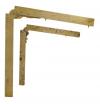  |
A SMALL BRASS SECTOR BY NICOLAS BION, PARIS, CIRCA 1690
signed N. Bion à Paris, and with scales for Les Cords, Les Solides, Les Partes a Gap etc - 4½in. (7.5cm.) folded length
£350-450
|
|

|
A FRENCH BRASS SECTION, CIRCA 1720
unsigned, engraved over both sides, scales for les cord, les plan, les métles, the edges inscribed Pied Francais and Pied Anglais - 7in. (17.5cm.) closed length
£200-300
|
|

|
AN ELECTRUM PLATED SQUARE PROTRACTOR/RULE BY GEORGE ADAMS, LONDON
signed Adams, Fleet Strt. London - 6in. (15cm.) wide
£200-300
|
|

|
A NICKEL-PLATED BRASS YARD RULE BY HOLTZAPFFEL & CO. LONDON, CIRCA 1900
signed as per title and one edge delineated with sub-divided inches; together with a nickel-plated brass French slide rule contained within a hinged wood case with securing hook - 21½in. (55cm.)
(2)
£150-250
|
|
| |
Ø A 19TH CENTURY IVORY PROOF GAUGE RULE BY DYCAS OF LIVERPOOL
inscribed over both sides - 12¼in. (31cm.) long; together with a folding 2ft ivory rule by E. Preston; and an unsigned two-draw ivory and gilt brass monocular
(3)
£100-150
|
|

|
Ø AN EARLY 19TH CENTURY LACQUERED BRASS PANTOGRAPH BY DOLLOND, LONDON
signed as per title, the frame with removable ivory wheels and contained within fitted keystone box with lead box and accessories - 26in. (56cm.) long
£100-150
|
|

|
Ø A MARINE BAROMETER BY W.B. ROSS, SUNDERLAND, CIRCA 1840
with ivory scales with mercury tube and maker's plate, alcohol thermometer to front, plain wooden shaft with brass weight gimballed suspension - 37in. (94cm.) high
£800-1200
|
|

|
A LATE 19TH CENTURY ANEROID FISHERMAN'S BAROMETER BY NEGRETTI & ZAMBRA FOR THE R.N.L.I
the 5in. enamelled dial with red principal letterings and numbers, signed as per title and numbered 559 contained within oxidised brass bulkhead case - 6in. (15cm.) diam; together with a brass Negretti & Zambra weather forecaster on easel stand - 4in. (12cm.) high
(2)
£200-300
|
|

|
AN EDWARDIAN SILVER POCKET BAROMETER
unsigned, mounted in substantial silver case with hallmarks for 1907 and lid with thumb-piece and inscribed to top S.G.E. FROM F.C.F.-H. FEB 8TH 1908 - 2¼in. (5.5cm.) diam
£400-600
| Models | |
|
 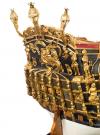 |
AN IMPRESSIVE 1:48 SCALE NAVY BOARD STYLE MODEL OF THE PRINCE [1670]
modelled by Alan Walker after the Science Museum original, 1974, the planked and pinned hull with carved and gilt decoration including figurehead, cat head, anchors with bound wooden stocks, knights, wreathed gun ports, numerous stern carvings including royal arms, etc., planked decks with fittings including belfry, lead lights, capstan, guns in carriages with shot racks and buckets, gratings, cutaway bound masts, and other details, mounted in an ebonised glazed case with casters, overall - 30½ x 53 x 17¾in. (77.5 x 134.5 x 45cm.)
£2000-3000
This model will be available for viewing at Imperial Road
|
|

|
A DETAILED AND WELL-PRESENTED WATERLINE MODEL OF H.M. SCHOONER ENTREPRENANTE AS DEPICTED AT TRAFALGAR
the 8in. planked hull with scored decks fitted with carronade and details including anchor winch, gratings, belaying rails and pins, bilge pumps, deck light, companion ways, compass box, tiller, fitted boat in stern davits, 12 carronades in sliders with shot racks and animated crew, mast with yard, standing and running rigging and full set of lined paper sails with reefing points, depicting sailing briskly in a green moulded sea in glazed wooded case with name plate - 12 x 16 x 8½in. (30.5 x 41 x 21.5cm.)
£300-500
|
|

|
A 1:75 SCALE STATIC DISPLAY MODEL OF THE RUSSIAN BALTIC PATROL SHIP MOSQUITO, ORIGINALLY BUILT AT THE ST. PETERSBURG ADMIRALTY YARD, 1875
modelled by G. Cheikhet with carved hull decorated with finely chiselled gilt brass bow and stern decoration, planked deck with detailed brass and wood fittings including anchors with davits, bilge pump, winches, bitts, deck lights, single 4in. gun on brass slides, planked boats in davits, raked masts with rigging and other details, mounted within glazed wooden case with plate - 19½ x 25½ x 10in. (49.5 x 65 x 25.5cm.)
£1500-2500
This model will be available for viewing at Imperial Road
|
|

|
A WELL PRESENTED ¼IN. : 1FT SCALE MODEL OF A 14FT ADMIRALTY-PATTERN PULLING AND SAILING DINGHY, OF CIRCA 1830
modelled by G. Cheikhet with planked wooden carvel hull, brass lined keel and wales, rudder with yoke, brass swivelling crutches, cross board, thwarts, two bundles of four oars and furled sail and mast, mounted within glazed wooden case - 6 x 12in. (15 x 30.5cm.) overall
£400-600
|
|

|
A FINELY CARVED MODEL OF A ROYAL NAVY SHIP'S GALLEY, PROBABLY FROM A NAVAL YARD MODEL SHOP, CIRCA 1890
the hull carved from the solid and painted externally, the hollowed interior with painted seats and upper works, with six finely carved oars lashed within and fine suspension chains to either end - 7½in. (19cm.); Associated stand
£500-800
|
|

|
A SCALE MODEL OF THE PILOT GIG SHAH OF 1826
modelled in fruit woods, fully framed with clinker-built planking, bottom boards, foot rests, thwarts and rowlocks for six oarsmen, finished in blue, white and varnish and mounted on a display base with pen presentation inscription to underside dated 1980 - 9in. (23cm.)
£150-250
|
|
 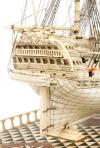 |
A FINELY RIGGED AND CARVED BONE PRISONER-OF-WAR STYLE MODEL OF THE 74-GUN SHIP BELLEROPHON
the planked and pinned hull with decorative carved leaf-and-flower main wale, open gun ports with brass guns and Venetian red lids, chain plates with deadeyes, warrior figurehead with carved head rails, quarter lights, bone anchors with bound bone stocks; planked deck with fittings including belaying rails, capstan, gratings, belfry, well deck, water casks, deck lights etc.; bound masts with yards, s'tun'sl booms, standing and running rigging with two launches rigged port and starboard and other details, mounted on a fine ebony and bone marquetry base with compass devices at either end and geometric flower design to centre, the balustrade with opposing lions and sphinx motif, overall measurements - 19¼ x 26in. (49 x 66cm.)
£4000-6000
Bellerophon, built 1786 by Graves and Co, Frindsbury as a 74 and commissioned 19th July, 1790 fought at the Battle of the Glorious 1st June (1793); the Battle of the Nile (1798) and the Battle of Trafalgar (1805). On July 15th 1815 she accepted the surrender of Napoleon and conveyed him first to Torquay and then to Plymouth. She was broken up at Plymouth 1834 after being renamed Captivity in 1826 and serving as a prison hulk
|
|
  |
TWO SIMILAR BUILDER'S STYLE MIRROR-BACKED HALF MODELS FOR THE STEAM TUGS SUN IV AND H209
carved from the solid with ebonised top sides, varnished superstructure and brass fittings, funnel and cutaway masts as appropriate, mounted within ebonised glazed cases with name plates, each - 12 x 32 x 5½in. (30.5 x 81.5 x 14cm.)
(2)
£500-800
|
|

|
A BUILDER'S STYLE HALF MODEL FOR A FRASERBURGH TRAWLER
the laminated carved hull with ebonised topside inscribed FR.73, lined propeller and rudder, carved superstructure with cutaway mast, etc., mounted on oak display board with frame, overall - 12 x 24in. (30.5 x 61cm.)
£200-300
|
|

|
A BUILDER'S STYLE MIRROR BACKED HALF-MODEL FOR A FRIGATE
carved from laminated wood with ebonised top side, gun ports, chain plates, Venetian red bulwarks, mounted on a mirror with wooden frame, overall - 13½ x 38in. (34 x 96.5cm.)
£200-300
|
|

|
A LIVE STEAM POWERED MODEL LAUNCH, CIRCA 1910
the hull carved from the solid and painted pink below the waterline with black boottop and varnished upper works, fitted with mahogany-lagged boiler to single cylinder engine with flywheel, propeller shaft and brass propeller, simple deck fittings and friction rudder - 19 x 51in. (48 x 129.5cm.)
£800-1200
This model will be available for viewing at Imperial Road
|
|

|
AN EARLY 20TH-CENTURY WOOD SAILING MODEL PROBABLY OF THE LAKE DISTRICT SHARPIE MAVIS
the hard chine hull with weighted drop keel planked and screwed deck with cleats and eyes, fitted cockpits with cupboards, mast with yard boom and set of early brick coloured linen sails and rigging - assembled dimensions approximately 57 x 54in. (145 x 137cm.)
£400-600
This model will be available for viewing at Imperial Road
|
|

|
A BERMUDAN RIGGED POND YACHT, CIRCA 1920
the planked and pinned hull with weighted keel, rudder, sprung bow sprit, access hatch and adjustable mast step, with wooden mast, linen sails in batons, and rigging with adjusting blocks, now fitted with servos to rudder, complete with radio control unit, loosely mounted on carry cradle with canvas strapping, overall measurements - 83 x 66in. (211 x 167.5cm.)
£700-900
This model will be available for viewing at Imperial Road
|
|
 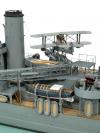 |
A FINELY DETAILED 1:200 SCALE WATERLINE MODEL FOR THE HEAVY CRUISER H.M.S. EXETER AS IN FITTED IN 1942
modelled by John R. Haynes with bespoke pre-formed hull with lined decks and minutely observed fittings as appropriate and including main and secondary armament, anti-aircraft guns, fully fitted bridge with binnacles, voice tubes, range finder, communications mast with radio aerials and lanyard, signal flag racks, fitted boats on launches, Supermarine Walrus seaplane, and much other fine detailing, set on a light green-blue base with plate, glazed wooden cover, overall measurements - 10½ x 39 x 8¾in. (26 x 99 x 22cm.)
£4000-6000
Exeter first came into prominence at the battle of the River Plate which ended in the destruction of the German pocket battleship Admiral Graf Spee, in December 1939. Having sustained the full weight of the enemy's heavy guns until her consorts, Ajax and Achillies, arrived, Exeter scraped through with four of her six 8in. guns out of action and her steering gear smashed. After a lengthy refit, early in 1942 she was in Far Eastern waters under Capt. O.L. Gordon, M.V.O., and, on February 27th she formed one of a force of cruisers and destroyers led by Rear-Admiral K. Doorman of the Royal Netherlands Navy engaged in repelling a Japanese landing in the Dutch East Indies. The Allied forces comprised, beside Exeter, the Dutch cruisers De Ruyter, (flagship) and Java, the Australian cruiser Perth, the U.S. heavy cruiser Houston, and the Dutch destroyer Kortenaer with the British destroyers Electra, Encounter and Jupiter. Not one ship of this unfortunate squadron escaped destruction. The Japanese force comprised the cruisers Nati and Haguaro, two lighter cruisers and about a dozen destroyers. Action was joined at about 4 o'clock in the afternoon, Exeter receiving a hit from an 8in. shell which caused great damage in the boiler room, putting six of her eight boilers out of action and considerably reducing her speed. In these circumstances she had no alternative than to go about for Sourabaya as she could not keep up with her consorts. At Sourabaya she made contact with the U.S. destroyer Pope and was later joined by Encounter, the three ships leaving under cover of night for Australia. For this voyage Exeter's maximum speed was at first 15 knots, but her engine room staff worked heroically through the night and by morning three more boilers were in use and speed had increased to 26 knots. Her plight was still very grave, however, as she had expended four-fifths of her 8in. gun ammunition in the recent action and was in no condition to fight a prolonged engagement. At 9.35 on the morning of March 1st the ships ran into three Japanese cruisers and some four or five destroyers and Exeter sent out a wireless message that she was about to engage the enemy. Despite the odds the battered cruiser fought well for over two hours after which time, at just before noon, she was sunk by her crew. Her boilers had been wrecked and all her ammunition expended before she sank. The loss on board the Exeter in both actions amounted to 54 officers and men killed. The survivors were taken prisoner by the Japanese and no less than 152 of them died in captivity. Capt. Gordon, who was released at the conclusion of hostilities, had preserved his records of the action in a tube of shaving cream. The destroyer Encounter sank shortly after the cruiser, but Pope, which scored a hit on a cruiser, ran into a rain squall and was not located for more than a hour, at the end of which time she was attacked and sunk by Japanese bombers
|
|
 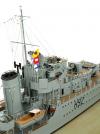 |
A FINELY DETAILED 1:192 SCALE WATERLINE MODEL FOR THE V.C. DESTROYER H.M.S. GLOWWORM AS FITTED IN 1938
modelled by John R. Haynes with bespoke pre-formed hull with minutely observed fittings as appropriate and including main and secondary armaments, fully fitted bridge with signalling masts, stayed funnels, fitted boats and launches in davits, pompom guns, search lights, torpedo, ship's bell, name plate, etc., mounted on a light green base within a glazed case, overall measurements - 7¾ x 25¼ x 6½in. (19.5 x 64 x 16.5cm.)
£2000-3000
The destroyer Glowworm commanded by Lt Cdr Gerald Roope, was one of the vessels engaged upon the mining of Norwegian waters to prevent their use by the Germans, more especially to interrupt the iron ore traffic between the port of Narvik and Germany. The operation began on April 8th, 1940, and coincided with the German invasion of Norway. Early on the morning of the 8th when escorting the battle cruiser Renown, Glowworm lost touch owing to one of her crew having fallen overboard. The delay was occasioned in picking up the man, together with the heavy seas which reduced the destroyer's speed to 10 knots, allowing a German force consisting of the 10,000 ton cruiser Hipper and four destroyers to intercept her. Action was joined at daybreak and Glowworm engaged first one and then two enemy destroyers. These vessels failed to score any hits, though the British vessel managed to get in at least one before the enemy broke off the action. Shortly afterwards the Hipper came in sight and began to shell the Glowworm. Lt Cdr Roope decided to make smoke and attack with torpedoes. This attempt failed and the more desperate plan of ramming the cruiser was put into operation and, despite a deluge of shell fire, succeeded in striking the enemy on the starboard side, though with insufficient force to cause vital damage. By this time Glowworm was a wreck and at about 10am Lt Cdr Roope gave the orders to abandon ship and the destroyer turned on her side and sank. Unfortunately, the strain of the action proved too much for the gallant commander who took to the water in an exhausted condition. He managed to reach the Hipper but failed to catch a rope thrown to him and was never seen again. He was posthumously awarded the Victoria Cross. The Admiral Hipper's commander, Kapitän zur See Heye, wrote to the British authorities via the Red Cross, recommending award of the VC for his opponent's courage in engaging a vastly superior warship. A 35-year-old Royal Navy officer, his action was the earliest awarded a Victoria Cross in the Second World War (although the award was gazetted after hostilities ended) and is one of very few to have the award justified, in part, from a recommendation and supporting evidence provided by the enemy. Of the Glowworm's complement of eight officers and 144 ratings, seven officers and 105 ratings were killed. Lieutenant Ramsey and 39 ratings were picked up by the Germans and of the number two men died while prisoners of war
|
|

|
A WELL PRESENTED AND MODELLED WATERLINE MODEL OF THE BATTLESHIP H.M.S. IRON DUKE, FLAG SHIP AT JUTLAND 1916
the laminated and carved wooden hull with lined paper plating and decks, with details including winches, main and secondary armaments, deck rails, companionways, fitted boats in davits, tripod mast with director firing, and other details, display at anchor with boarding sponsons out, on a painted green sea within glazed wooden case, overall measurements - 12½ x 47 x 13½in. (32 x 119.5 x 34.5cm.)
£1000-1500
The formidable Iron Duke, the nameship of the class of four battleships, was laid down in January 1912, launched in October the same year and completed in March 1914. Built at Portsmouth, she displaced 25,000 tons, measured 580 feet in length with a 90 foot beam and carried a main armament of 10 x 13½in. guns. Additionally armed with 12 x 6in. guns, the first British big-gun warship to be so, she and her sisters could steam at 21 knots and were the last coal-burning battleships in the fleet. Flagship to the Home Fleet when first commissioned, she became flagship to the C.-in-C. (Admiral Jellicoe) upon the outbreak of War and, in this capacity, was present at the Battle of Jutland. Thereafter with the 2nd Battle Squadron until the end of War, she was in the Mediterranean from 1916-26 and then in the Atlantic until 1929 after which she was reduced to a training ship. Relegated to Scapa Flow as a depot ship in 1939, she survived the Second World War despite bomb damage and was sold for scrapping in 1946
|
|

|
A WELL PRESENTED AND DETAILED 1:192 SCALE WATERLINE MODEL OF THE HUNT CLASS DESTROYER H.M.S. BADSWORTH, ORIGINALLY BUILT BY CAMMELL LAIRD, 1941
modelled by E. Dyke with carved hull finished in dazzle camouflage, grey decks with fittings as appropriate including anchors with chains and winches, deck rails, bitts, ventilators, main and secondary anti-aircraft armament, wooden decked open bridge with controls, communication masts, stayed funnel, carlie floats, launch and boat in davits, mine racks to stern with mines, etc., set on a blue base within plexi-glass case, overall measurements - 7 x 21½ x 7in. x (18 x 52 x 18cm.)
£600-800
Commissioned in August 1941, Badsworth was prepared for close convoy escort duties, initially in the north west approaches, and then to Russia during which she fought off repeated attacks and saved many men from the water; in May 1942 she was allocated to Operation Harpoon, escorted essential supplies to Malta during which she was badly damaged when she hit a mine entering the Grand Harbour and docked until November for repairs. Deployed thereafter in the Atlantic, and then Western Mediterranean, she hit another mine and beached herself to avoid sinking. Refloated and repaired, she was loaned to the Norwegian Navy as HNoMS Arendal in 1944 and purchased by them after the War. She was broken up in 1965.
|
|

|
A WATERLINE MODEL OF H.M. SUBMARINE CONQUEROR [1969]
constructed from carved laminated wood finished in black and depicted with forward steering vanes and conning tower with officers' and communication aerials passing through a calm moulded seascape with painted white foam wash, on raised wooden display base - 6 x 48 x 13in. (15 x 122 x 33cm.)
£300-500
The 4000 ton 'Valiant' Class nuclear attack submarine Conqueror was laid down by Cammell Lair on the 5th December 1967, launched eighteen months later and completed in November 1971. Perhaps her greatest moment has also remained her most controversial - the sinking of the General Belgrano on 2nd May 1982 during the Falklands campaign which has provoked impassioned debate ever since. She was sold for breaking in 1990.
|
|

|
A 1:96 SCALE STATIC DISPLAY MODEL FOR THE C.S. MERCURY, ORIGINALLY BUILT BY CAMMELL LAIRD, 1962
modelled by K. Routledge with carved laminated wooden hull, lined boxwood decks with painted wood and metal fittings including split bow with cable drum, open cable hatch with equipment, winches, bollards, bitts, white superstructure with glazed bridge with awning stanchions over, communications mast, covered lifeboats in davits and one motor launch, twin buff coloured funnels, and divided stern for cable drum and other details, mounted on two turned brass pedestals on baize-lined base with maker's and specification plates, plexiglass cover - 19½ x 68½ x 13½in. (49.5 x 74 x 34cm.); together with a souvenir for the Mercury and a receipt from the modeller dated 1996
(3)
£1000-1500
This model will be available for viewing at Imperial Road
|
|

|
A 1:100 SCALE BOARDROOM MODEL FOR THE M.S. VIRGINIA, CONSTRUCTED BY VAN DIEPEN WATERHUIZEN, HOLLAND FOR HARRISON'S (CLYDE LTD), 1970
the moulded hull with bilge keels, gilt propeller, ochre coloured decks with grey fittings as appropriate, white superstructure and other details, mounted on four plain aluminium posts within Perspex case with plate - 14¾ X 37¾ x 9½in. (37 x 95.5 x 24.5cm.)
£600-800
This model will be available for viewing at Imperial Road
|
|

|
A 1:100 SCALE BOARDROOM STYLE MODEL OF THE M.S. STABILITY BY NORMAN HILL, 2012, ORIGINALLY BUILT BY GOOLE SHIP BUILDING 1978
the laminated wooden hull with gilt propeller, ochre coloured deck, wooden hatch covers, white superstructure with other fittings as appropriate including lifeboats in davits, livery funnels, contained within a brass bound glazed case - 15 x 35 x 10in. (38 x 89 x 25.5cm.)
£600-800
This model will be available for viewing at Imperial Road
|
|

|
A TRAVEL AGENT'S WATERLINE MODEL FOR THE R.M.S. WINDSOR CASTLE, 1959
carved wooden hull, with metal top-sides finished in grey, green and brown as appropriate, liveried funnel, comms mast and other details, mounted to a plain blue cloth base within silver painted glazed case - overall 15 x 57 x 10in. (38 x 145 x 26cm.); together with framed prints of the Windsor Castle and the Andes
(3)
£2000-3000
This model will be available for viewing at Imperial Road
|
|

|
A TRAVEL AGENT'S WATERLINE MODEL FOR THE PASSENGER CARGO SHIP M.V. AKAROA, ORIGINALLY BUILT FOR SHAW SAVILL LINE BY HARLAND & WOLFF, 1959
modelled by Heaton Tabb, London, with painted composite hull with internal light fittings, planked boxwood decks with painted metal fittings including bitts, bollard, winches, companionways, rigged derricks, covered lifeboats on davits, forward superstructure with overbridge, benches, tennis courts, deck rails, swimming pools, etc., mounted on a moulded waterline base with bow and stern plates and maker's label, contained within a glazed wooden case - 16½ x 47½ x 14in. (42 x 121 x 36cm.)
£1500-2500
This model will be available for viewing at Imperial Road
|
|

|
A TRAVEL AGENT'S WATERLINE MODEL FOR THE S.S. CANBERRA, BUILT BY HARLAND & WOLFF LTD FOR P&O, CIRCA 1961
the carved hull with metal top-sides, finished in white and green contrasting decking as appropriate, twinned yellow funnels and comms masts, set on a plain blue base with plates, within brass-bound glazed case - 17½ x 53 10½in. (44.5 x 134.5 x 26.5cm.)
£2000-3000
This model will be available for viewing at Imperial Road
|
|

|
A SMALL-SIZED TRAVEL AGENT'S WATERLINE MODEL FOR THE ROYAL ROTTERDAM LLOYD LINER M.V. WILLEM RUYS , 1947
modelled by C. Doubleman, Holland, the carved painted hull, lined paper decks with detailed fittings as appropriate including lifeboats in davits, mast with radio aerials over bridge with range finders etc., mounted on a plain blue plexiglass base with maker's label on ebonised base with glazed brass bound cover - 6½ x 24 x 6½in. (16.5 x 61 x 16.5cm.)
Ordered in 1939, the launch was delayed until 1946 by World War II. Registered at 21,119 tons and 642 ft in length, she was unlucky early in her career when she was involved in a serious collision with the Oranje in 1953. Sold in 1965 to Flotta Lauro (later Lauro Line) and extensively refitted, she is chiefly remembered for the extraordinary hijacking by members of the PLO in October 1985 who murdered disabled American Jew Leon Klinghoffer and then threw his body overboard. The ship continued in service and was reflagged in 1987 when the Lauro Line was taken over by the Mediterranean Shipping Company to become Star Lauro. On November 30, 1994, she caught fire off the coast of Somalia while en route to South Africa. The crew attempted to battle the fire for several hours but were unsuccessful. Abandoned, the vessel sank on December 2nd
£800-1200
|
|

|
A DETAILED 32FT:1IN SCALE MODEL OF THE LEYLAND LINE PASSENGER/CARGO SHIP CALIFORNIAN [1902]
modelled by R.A. Wilson with masts, derricks and rigging, anchors, winch, bollards, ventilators, deck rails, deck winches, hatches, superstructure with wheelhouse with open bridge over with awning stanchions, stayed funnel with safety valve extension pipes, engine room lights, aft deck house and six lifeboats with thwarts in davits, finished in red and black with white upperworks and natural wood decks and mounted on two turned brass columns, glazed case - 6¾ x 19¼in. (17.2 x 49cm.), carrying box
£400-600
Californian was thought to be the mystery ship that slept whilst Titanic sank about ten miles away on the horizon. Although this was never proven, Captain Stanley Lord (1877-1962) - known as 'Lord of the Californian' never recovered his reputation and was dismissed from Leyland Line in August 1912, spending the rest of his life trying to clear his name. Interestingly the deathbed confession in 1965 of a Norwegian seal smuggler called Hendrik Ness seems to confirm Lord's story. When their ship, the S.S. Smansun, lying 4-5 miles off Titanic with a hold full of contraband, saw the first distress rockets fired they extinguished all lights and effectively disappeared - they were not fitted with wireless and Captain and crew agreed a pact of silence when they learned the shocking news in Iceland. Californian, registered at 6,223 tons - about 40,000 less than Titanic - was torpedoed on 9th November 1915 by U-34 61 miles southwest of Cape Matapan in passage between Salonica and Marseilles in ballast.
|
|

|
AN ATTRACTIVE MIRROR-BACK HALF MODEL FOR THE R.M.S. MAURETANIA, CIRCA 1910
the hull carved from the solid with red below the waterline and black with blued and gilt portholes, lined deck with detailed fittings including winches, capstan, ventilators, etc., covered lifeboats in davits, stayed funnels with safety values and pipes, masts with rigging and radio aerial and Cunard flag, mounted on mirror with two faux supports within fully glazed case with taped sides - 9 x 29½ x 3in. (23 x 75 x 7.5cm.)
£700-900
During work to correct a cracked side panel, the backing board was found to have a newspaper liner between the backing board and mirror reporting the trial of Dr Crippen in 1910 (this has now been pasted to the reverse); it has been suggested that this unusually detailed yet small model may have been one of the more expensive items available from the Mauretania's barber's shop where souvenirs could be purchased.
|
|

|
A ¾IN. :1FT SCALE HALF-BLOCK BUILDER'S MODEL OF A CRASH RESCUE TENDER BY VOSPER LTD, PORTSMOUTH FOR THE AIR MINISTRY
carved in contrasting woods and mounted on a mahogany backboard with builder's plate. Overall measurements - 9¾ x 41¼in. (24.8 x 104.8cm.)
£600-800
|
|

|
A ½IN. : 1FT SCALE BUILDER'S HALF-BLOCK MODEL FOR A HIGH SPEED PASSENGER LAUNCH, BUILT BY VOSPER LTD, PORTSMOUTH FOR SHELL LTD
carved from contrasting laminated woods and mounted on an ebonised backboard with builder's plate. Overall measurements - 10 x 44in. (25.4 x 111.8cm.)
£600-800
|
|
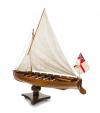 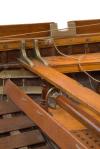 |
A 1:5 SCALE ROYAL NAVY CADET TRAINING MODEL FOR A SAILING AND PULLING CUTTER GIG, CIRCA 1890
constructed and fitted as in authentic practice in pine and oak with pinned clinker hull, foot-rests with rope foot holders, gratings, cast brass knees and rowlocks, bottom boards, keel hoist, windlass, slatted stern seat with removable transom board, rudder with tiller, collapsible mast with stitched lug and foresails with reefing points and woven standing and running rigging with sheathed blocks and tackle, mounted on lead ball joint to quatrefoil stand with casters - 90 x 84 x 20½in. (229 x 213.5 x 52cm.)
£4000-6000
A similar model is held in the National Collection at Greenwich (SLR1318) and which it is stated was made by Dockyard Apprentices in Plymouth; The ball joint allows the model to be set at any angle for instruction.
This model will be available for viewing at Imperial Road
|
|

|
A 1IN.:1FT SCALE DOCK YARD MODEL FOR AN ADMIRALTY-PATTERN WHALER, JOSEPH WHITE, COWES, CIRCA 1870
framed with pinned clinker hull with air cased bulwarks, cross boards, thwarts, gratings, detachable rudder with yoke and furled sail - 3 x 26in. (7.5 x 66cm.); later display stand
Provenance: R. & J. White, Cowes, and thence by descent.
Literature: May, W.E. The Boats of Men of War, NMM, 1999, p. 73
£800-1200
|
|
 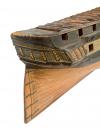   |
A DOCKYARD HALF MODEL FOR THE MODIFIED 'CONSTANCE' CLASS 50-GUN FRIGATE PHAETON, BY JOSEPH WHITE, COWES, CIRCA 1845
planked and pinned in boxwood with contrasting ebonised and white topsides pierced with gun ports, gilt decoration to quarter lights and cat head, chain plates with deadeyes and partially framed interior - 54½ x 11in. (138.5 x 28cm.) overall; together with the dockyard ink and paper profile plan and specification for Phaeton (repaired tear, old wear) - 17 x 39in. (43 x 99cm.); and three steam conversion proposal drawings comprising a profile, stern view and hull form delineated in ink on linen with principal dimensions listed lower left (titles and inscription to top faded) - 21 x 71in. (53.5 x 180.5cm.); and tinted ink and watercolour profiles of the principal armament and engine arrangements on conjoined paper sheets - 13 x 56½in. (33 x 143.5cm.)
(4)
£1500-2500
Provenance: R. & J. White, Cowes, and thence by descent.
Although designed by White, this ship was actually built at the Deptford Dockyard; as the model and profile remained with the White family, it suggests it was made as part of the early design process and not after completion. Phaeton was a 184ft frigate of 1,942 tons burthen, manned by 500 men and armed with 40 x 23pdr plus 10 x 8in. guns. Launched in November, 1848 she was converted to steam in 1859 at Sheerness DY by James Watt & Co. and broken up in 1875. Whites steam conversion plans differ from what Watt & Co produced so these are presumably rejected proposal plans.
|
|

|
A HALF BLOCK BUILDER'S MODEL FOR A PASSENGER PADDLE STEAMER, CIRCA 1880
the laminated carved hull with ebonised topsides, plain deck with cut-away mast and funnel, mounted on a display board with contrasting woods at waterline - 9 x 44in. (23 x 112cm.)
£800-1200
|
|

|
A BUILDER'S HALF BLOCK MODEL FOR THE IRON FRAMED SHIP JOHN C. MUNRO, BUILT BY SIR JAMES LAING & SONS. LTD., SUNDERLAND (DEPTFORD YARD) FOR MUNRO & CO., 1862
the laminated and carved yellow pine hull with stained topsides and enhanced grain, plain decks and cut-away masts, mounted on a painted display board with cut-away corners and mss note to reverse reading Half model of my Great Grandfather's sailing ship the "John Munro" - 12½ x 52¼in. (32 x 133cm.)
£800-1200
This 612 ton ship was built for use on the London-Australia run and disappears from Lloyds Register by 1889
|
|

|
A BUILDER'S HALF-BLOCK MODEL PROBABLY FOR A CLIPPER, CIRCA 1860
the laminated and carved hull painted pink below the waterline, black to topsides with metal portholes above boxwood stringing, mounted in wooden display board (old wear and restoration) 12 x 49in. (30.5 x 124.5cm.)
£600-800
|
|
   |
A HALF BLOCK BUILDER'S MODEL FOR THE STEAM TUG FLYING EAGLE BUILT BY BOW, MCLACHLAN & CO. FOR THE CLYDE SHIPPING CO. LTD, 1928
the laminated carved hull varnished below the water line with lined propeller and rudder, ebonised topsides with lined brown superstructure cutaway funnel and mast, mounted on a wooden display base with ivorine builder's plate, overall 12 x 32 (30.5 x 81.5cm.)
£800-1200
This 260 tons 105ft tug reverted to an older style when completed and her beam was about three foot wider than her near contemporaries and capable of an impressive 950 i.h.p. Designed with coastal towing in mind, she had a large coal capacity which was loaded through a hatch located between the wheelhouse and funnel. She remained with Clyde Shipping for thirty years during which time she towed many of the world's most iconic liners and was sold to J.H. Lamey of Liverpool who added a flying bridge and re-name her James Lamey; in 1966 she was sold to Chas. Brand Ltd. and worked in Belfast as the Lilias until 1969 when she was sold for breaking.
|
|
  |
A BUILDER'S MODEL FOR THE M.T. RECRUIT BY RICHARD DUNSTON LTD, THORNE, YORKS FOR WILLIAM CORY & SON LTD, 1952
modelled by Sinclair Model Engineering Ltd, with laminated and carved hull with red decks, black superstructure with silver fittings, fitted bridge, winches, life buoys, lined paper wood deck section and hatches, netted fenders to stern and bow button, mounted on two supports to display base with maker's plates within glazed wooden case - 16¼ x 28 x 11¼in. (41 x 71 x 28cm.)
£1200-1800
One of a pair of 91grt tugs (her sister is the Swiftstone) built for Corys (Thames) Lighterage Ltd, the Recruit has remained with the firm and its various incarnations ever since and, apart from being re-engined in 1996, is still in service a full sixty-six years later. The Swiftstone was handed over to a heritage trust in 1999
This model will be available for viewing at Imperial Road
|
|
  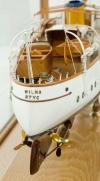 |
THE BUILDER'S MODEL FOR THE TWIN-SCREW MOTOR YACHT AND 'LITTLE SHIP' WILNA R.T.Y.C., LATTERLY H.M.S. AISHA, BUILT BY COCHRANE & SONS LTD, SELBY, 1934
modelled by C. Crawford & Sons, Sunderland with laminated wooden hull, lacquered lined decks, gilt fittings, painted superstructure, and details including carved lifeboats in davits, gratings, deck lights, awning stanchions, raked buff funnel, searchlights, life buoy etc., mounted on four gilt pedestals on display base with ivorine plate and light oak glazed case. Overall measurements - 16 x 32 x 10½in. (40.5 x 81.5 x 26.5cm.); together with a copy of her construction contract; a set of builder's plans of her general arrangement; a period photograph and some correspondence with Cochrane's from 1992
(4)
£3000-4000
Designed by Norman Hart and built of steel, the 100ft long Wilna registered just over 117 tons and cost her owner, one Mr. W.H. Collins, £14,400. By 1939 Mr Collins had ordered a larger eponymous replacement from Camper Nicholson and the first Wilna represented by this model was sold to the Royal Navy in February 1940. Renamed H.M.S. Aisha she was deployed on harbour patrol, but was ideally placed when the Admiralty transmitted its requisition to owners of private craft to surrender (and if possible man) them in the frantic efforts to evacuate the British Expeditionary Force from the Dunkirk beaches 26th May - 4th June 1940. Shattered and demoralized, the British were trounced by the German 'Blitzkrieg' as it ripped through France in the late Spring of 1940 and found itself surrounded and under air attack. With the Royal Navy suffering heavy losses from its precious reserves, larger ships presented an easy target for the Luftwaffe and were sunk at the pier heads blocking other vessels from loading troops. The answer was to use smaller craft capable of reaching the beach to ferry the army to the larger ships waiting in deeper water, or to simply ferry as many men back to Britain as best as possible. Over seven hundred private craft measuring between 30 and 100 feet in length responded - known to eternity as the Dunkirk 'Little Ships' - and saved over 338,000 men in what instantly became known as the 'Miracle of Dunkirk'. With the professional army saved from destruction, it was now possible for Churchill and his War Cabinet to regroup and prepare for the defence of the United Kingdom. Sadly Aisha's war was a short one as she was sunk by a mine in the Thames estuary in October 1940 where her perfectly-preserved wreck was discovered in 2008; The second Wilna registering 460 tons built by Camper & Nicholson was delivered to Mr Turner in early 1939 and hired that August as an anti-submarine yacht. She was sunk off Portsmouth by aircraft on 24th March 1941
This model will be available for viewing at Imperial Road
|
|

